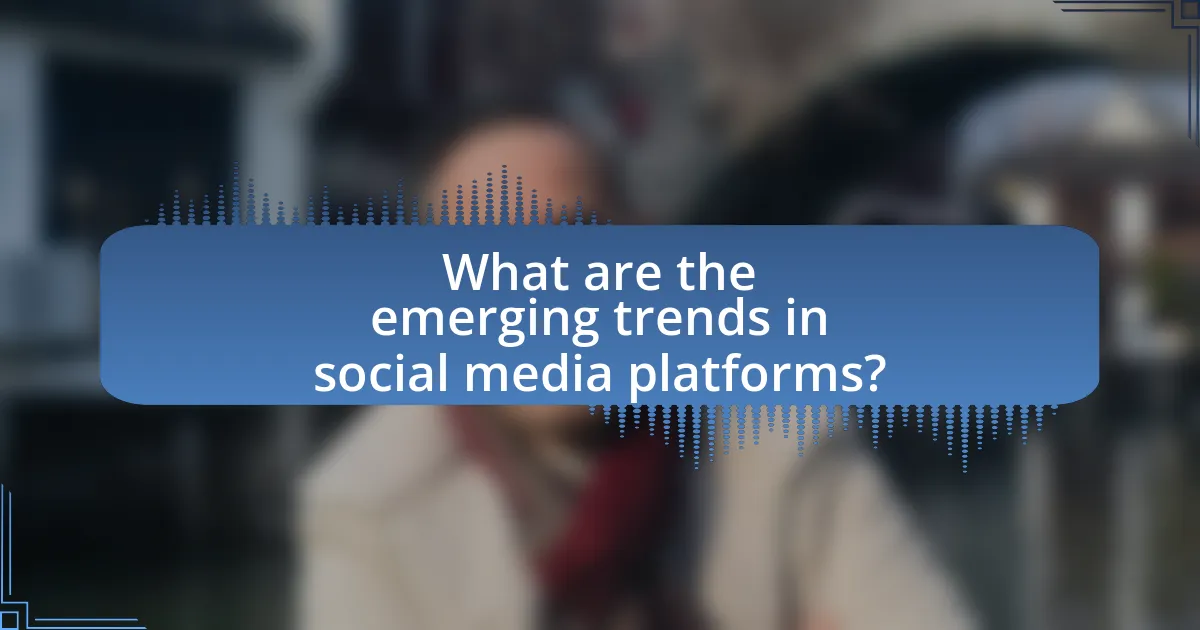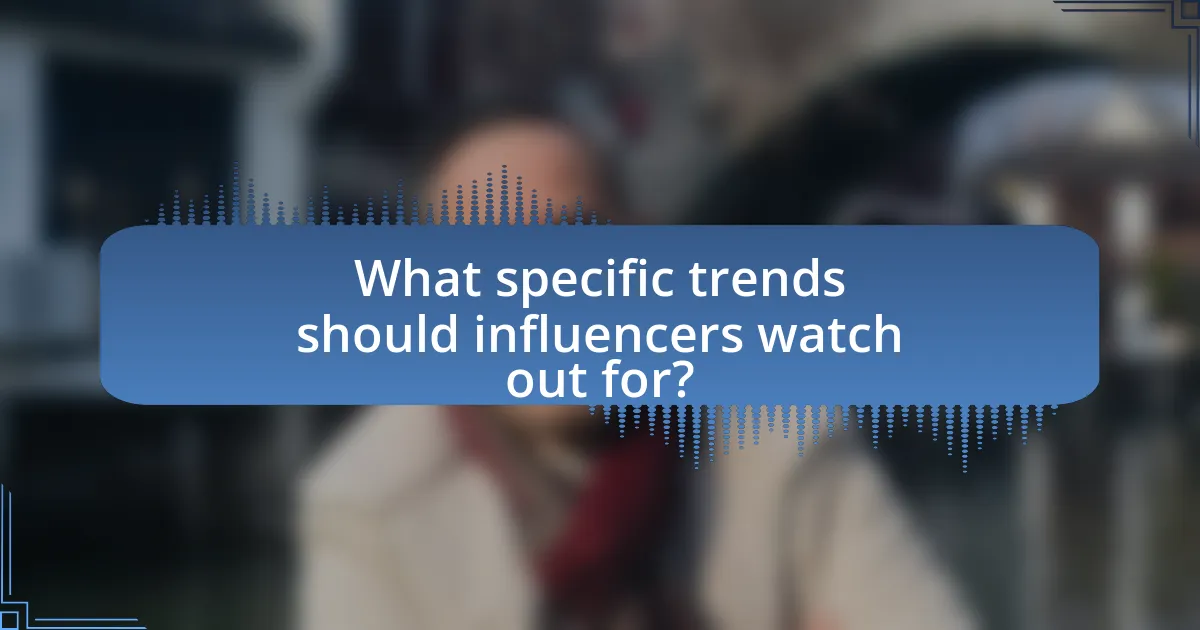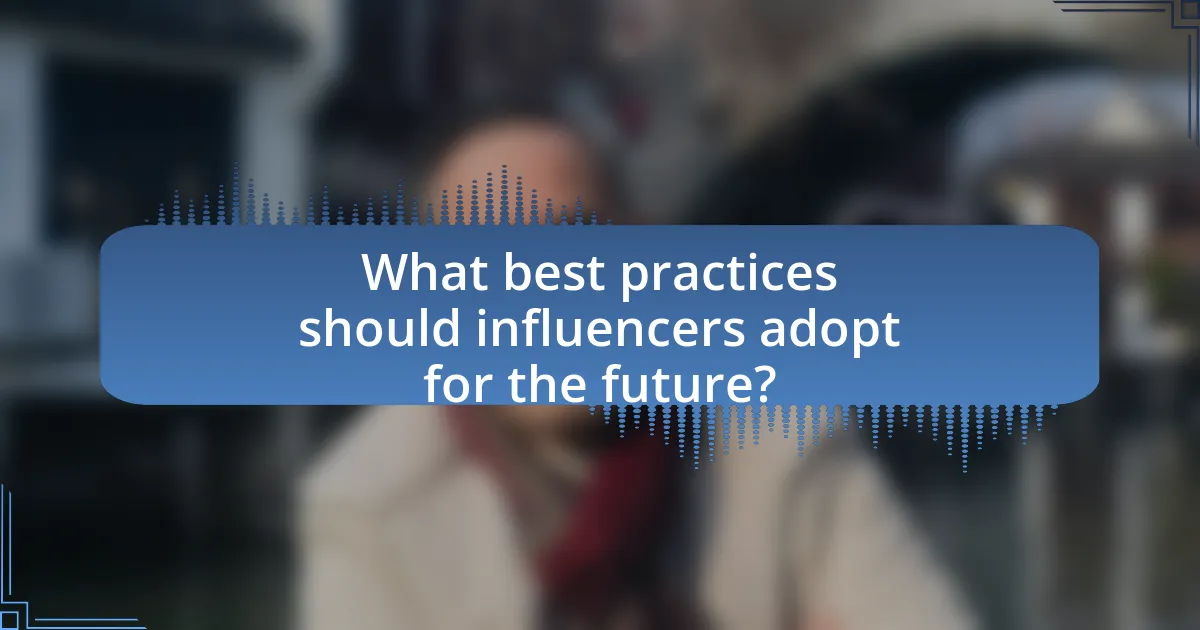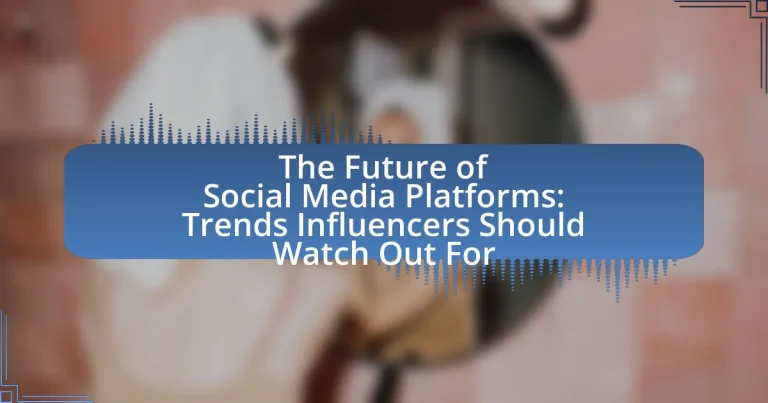The article focuses on the future of social media platforms, highlighting emerging trends that influencers should monitor. Key trends include the rise of short-form video content, increased emphasis on privacy and data security, and the integration of augmented reality features. It discusses factors influencing user engagement, the impact of demographics on social media usage, and the role of technological advancements like artificial intelligence. Additionally, the article examines how influencers can adapt their strategies to remain relevant, the significance of niche communities, and best practices for maintaining audience trust and engagement in an evolving digital landscape.

What are the emerging trends in social media platforms?
Emerging trends in social media platforms include the rise of short-form video content, increased focus on privacy and data security, and the integration of augmented reality (AR) features. Short-form videos have gained popularity due to platforms like TikTok, which reported over 1 billion monthly active users in 2021, driving engagement and content creation. Privacy concerns have led platforms to implement stricter data protection measures, as seen with changes in policies by Facebook and Instagram in response to user demands. Additionally, the incorporation of AR features, such as Instagram filters and Snapchat lenses, enhances user interaction and engagement, reflecting a shift towards immersive experiences.
What factors influence user engagement on social media?
User engagement on social media is influenced by several key factors, including content quality, audience interaction, platform algorithms, and timing of posts. High-quality, relevant content attracts users and encourages them to interact, while algorithms prioritize posts that generate engagement, further amplifying visibility. Additionally, the timing of posts can significantly impact engagement rates, as content shared during peak user activity periods tends to receive more interactions. Research indicates that posts with images or videos receive 94% more views than text-only posts, highlighting the importance of multimedia in driving engagement.
How do demographics affect social media usage trends?
Demographics significantly influence social media usage trends by determining which platforms are favored by different age groups, genders, and socioeconomic statuses. For instance, younger users, particularly those aged 18-29, predominantly use platforms like TikTok and Instagram, while older demographics, such as those over 50, tend to prefer Facebook. According to the Pew Research Center, as of 2021, 71% of adults aged 18-29 use Instagram, compared to only 23% of those aged 65 and older. Additionally, gender differences are evident, with women more likely to use platforms like Pinterest, while men gravitate towards platforms like Reddit. This demographic segmentation shapes content creation, marketing strategies, and user engagement on social media platforms, reflecting the varying preferences and behaviors of distinct user groups.
What technological advancements are shaping social media?
Artificial intelligence (AI) and machine learning are the primary technological advancements shaping social media. These technologies enable platforms to analyze user behavior, personalize content, and enhance user engagement through targeted advertising. For instance, AI algorithms can predict user preferences based on past interactions, leading to more relevant content delivery. According to a report by Statista, 80% of marketers believe that AI will revolutionize marketing by 2025, highlighting its growing influence in social media strategies. Additionally, advancements in augmented reality (AR) and virtual reality (VR) are transforming user experiences, allowing for immersive interactions and innovative advertising formats. A survey by Deloitte found that 75% of consumers are interested in using AR for shopping, indicating its potential impact on social media commerce.
How is artificial intelligence impacting social media platforms?
Artificial intelligence is significantly impacting social media platforms by enhancing user experience through personalized content recommendations and improving content moderation. AI algorithms analyze user behavior and preferences to curate feeds that align with individual interests, leading to increased engagement; for instance, platforms like Facebook and Instagram utilize machine learning to suggest posts and advertisements tailored to users. Additionally, AI-driven tools help in detecting and removing harmful content, such as hate speech and misinformation, which is crucial for maintaining community standards and user safety. According to a report by the Pew Research Center, 64% of social media users believe that AI can help improve their online experience by filtering out irrelevant content.
What role does augmented reality play in future social media experiences?
Augmented reality (AR) will significantly enhance future social media experiences by enabling immersive interactions and personalized content. AR technology allows users to overlay digital information onto the real world, creating engaging environments for social interaction, brand marketing, and user-generated content. For instance, platforms like Snapchat and Instagram have already integrated AR filters, which have proven to increase user engagement by up to 70%, according to a study by Snap Inc. This trend is expected to expand, as AR can facilitate virtual try-ons for products, interactive storytelling, and real-time collaboration among users, thereby transforming how individuals connect and share experiences online.
What are the implications of privacy concerns on social media platforms?
Privacy concerns on social media platforms lead to increased regulatory scrutiny and user distrust. As users become more aware of data breaches and misuse of personal information, platforms face pressure to enhance data protection measures. For instance, the implementation of the General Data Protection Regulation (GDPR) in Europe has forced companies to adopt stricter privacy policies, impacting how they collect and manage user data. Additionally, studies show that 81% of users feel they have little control over their personal information online, which can result in decreased user engagement and a shift towards platforms that prioritize privacy. This shift may also drive innovation in privacy-focused technologies, influencing the future landscape of social media.
How are platforms adapting to new privacy regulations?
Platforms are adapting to new privacy regulations by implementing stricter data protection measures and enhancing user consent protocols. For instance, many social media companies have updated their privacy policies to comply with regulations like the General Data Protection Regulation (GDPR) in Europe and the California Consumer Privacy Act (CCPA) in the United States. These adaptations include features such as clearer consent forms, options for users to manage their data, and transparency reports that outline data usage. According to a report by the International Association of Privacy Professionals (IAPP), over 80% of organizations have made significant changes to their data handling practices in response to these regulations, demonstrating a widespread commitment to compliance and user privacy.
What strategies can influencers use to maintain trust with their audience?
Influencers can maintain trust with their audience by consistently providing authentic and transparent content. Authenticity involves sharing genuine experiences and opinions, which fosters a sense of reliability among followers. Transparency includes disclosing partnerships and sponsorships, as evidenced by the Federal Trade Commission’s guidelines that require influencers to clearly label paid promotions. By adhering to these practices, influencers can build and sustain a trustworthy relationship with their audience, ultimately leading to increased engagement and loyalty.
How are brands leveraging social media trends?
Brands are leveraging social media trends by creating content that aligns with current user interests and behaviors, thereby enhancing engagement and brand visibility. For instance, many brands utilize trending hashtags and challenges to participate in viral conversations, which can significantly increase their reach. According to a report by Sprout Social, 70% of consumers feel more connected to brands that engage with them on social media, demonstrating the effectiveness of this strategy. Additionally, brands are increasingly collaborating with influencers who embody these trends, allowing them to tap into established audiences and enhance authenticity. This approach not only drives traffic but also fosters community around the brand, as evidenced by the success of campaigns that integrate user-generated content reflecting popular trends.
What types of content are most effective for brand engagement?
Visual content, particularly videos and images, is most effective for brand engagement. Research indicates that posts with visuals receive 94% more views than those without, highlighting the importance of eye-catching graphics and dynamic video content in capturing audience attention. Additionally, interactive content such as polls, quizzes, and live streams fosters higher engagement rates, as they encourage audience participation and create a sense of community. According to a study by HubSpot, interactive content generates twice the engagement of static content, proving its effectiveness in enhancing brand interaction.
How can brands utilize influencer partnerships in the evolving landscape?
Brands can utilize influencer partnerships by strategically aligning with influencers whose audiences match their target demographics, thereby enhancing brand visibility and credibility. This alignment allows brands to tap into the influencer’s established trust with their followers, which can lead to higher engagement rates and conversion. For instance, a study by the Digital Marketing Institute found that 49% of consumers depend on influencer recommendations for their purchasing decisions, highlighting the effectiveness of these partnerships in driving sales. Additionally, brands can leverage data analytics to measure the impact of influencer campaigns, ensuring that their marketing strategies remain agile and responsive to changing consumer behaviors in the evolving social media landscape.

What specific trends should influencers watch out for?
Influencers should watch out for the trend of short-form video content, which has gained immense popularity across platforms like TikTok and Instagram Reels. This format caters to the decreasing attention span of audiences, with studies indicating that short videos can increase engagement rates significantly, often exceeding 60% compared to longer content. Additionally, the rise of social commerce, where platforms integrate shopping features directly into social media, is transforming how influencers monetize their content, with e-commerce sales through social media expected to reach $1.2 trillion by 2025. Lastly, the growing emphasis on authenticity and transparency in influencer marketing is reshaping brand partnerships, as consumers increasingly favor genuine connections over polished advertisements, leading to a shift in how influencers present their collaborations.
How is the rise of short-form video content affecting influencers?
The rise of short-form video content is significantly enhancing influencers’ engagement and reach. Platforms like TikTok and Instagram Reels have shifted audience preferences towards quick, digestible content, compelling influencers to adapt their strategies. According to a report by HubSpot, 54% of consumers prefer short-form videos over other content types, indicating a strong demand for this format. Consequently, influencers are increasingly focusing on creating concise, impactful videos that capture attention quickly, leading to higher viewer retention and interaction rates. This trend not only boosts their visibility but also opens new monetization opportunities through brand partnerships tailored to short-form content.
What platforms are prioritizing short-form video, and why?
TikTok, Instagram, and YouTube are the primary platforms prioritizing short-form video content. TikTok revolutionized the format with its algorithm that promotes engaging, bite-sized videos, leading to rapid user growth and high engagement rates. Instagram introduced Reels to compete with TikTok, allowing users to create and share 15 to 60-second videos, which has significantly increased user interaction on the platform. YouTube launched Shorts to capture the growing demand for quick, entertaining content, leveraging its vast user base and existing infrastructure. These platforms prioritize short-form video to enhance user engagement, capitalize on the trend of quick consumption, and attract advertisers looking for innovative ways to reach audiences.
How can influencers create compelling short-form video content?
Influencers can create compelling short-form video content by focusing on storytelling, authenticity, and audience engagement. Storytelling captivates viewers, as research shows that narratives can increase viewer retention by up to 65%. Authenticity builds trust; studies indicate that 86% of consumers prefer content from relatable influencers. Engaging directly with the audience through comments and polls fosters community, enhancing viewer loyalty. By combining these elements, influencers can effectively capture attention and drive engagement in their short-form videos.
What is the significance of niche communities in social media?
Niche communities in social media are significant because they foster targeted engagement and create spaces for like-minded individuals to connect. These communities enable users to share specific interests, leading to higher interaction rates and more meaningful conversations. For instance, a study by the Pew Research Center found that 70% of social media users are part of at least one group that aligns with their interests, demonstrating the importance of these communities in enhancing user experience and satisfaction. Additionally, brands can leverage niche communities for more effective marketing strategies, as they can tailor their messages to resonate with specific audiences, resulting in increased brand loyalty and conversion rates.
How can influencers identify and engage with niche audiences?
Influencers can identify and engage with niche audiences by utilizing data analytics tools to analyze audience demographics and interests. These tools, such as Google Analytics and social media insights, provide concrete data on follower behavior, allowing influencers to tailor their content to specific interests. For example, a study by HubSpot found that 70% of marketers believe that understanding audience segments leads to more effective engagement strategies. By creating targeted content that resonates with these identified segments, influencers can foster deeper connections and enhance audience loyalty.
What strategies can influencers use to build community around their brand?
Influencers can build community around their brand by engaging authentically with their audience through consistent interaction and personalized content. This strategy fosters a sense of belonging and loyalty among followers. For instance, influencers can utilize live Q&A sessions, polls, and direct messages to create two-way communication, which has been shown to increase audience engagement by up to 50% according to a study by HubSpot. Additionally, hosting exclusive events or creating private groups on platforms like Facebook or Discord can enhance community ties, as these spaces allow for deeper connections and discussions among followers.
How are social commerce trends evolving on social media platforms?
Social commerce trends are evolving on social media platforms by integrating shopping features directly into user experiences, enhancing convenience and engagement. Platforms like Instagram and Facebook have introduced shoppable posts and live shopping events, allowing users to purchase products without leaving the app. According to a report by eMarketer, social commerce sales in the U.S. are projected to reach $45.74 billion by 2022, highlighting the growing importance of these features. Additionally, TikTok has launched TikTok Shop, enabling creators to sell products directly through their videos, further blurring the lines between content and commerce. This evolution reflects a shift towards a more seamless shopping experience, driven by user demand for instant access to products and services.
What features are being introduced to facilitate social commerce?
New features being introduced to facilitate social commerce include shoppable posts, live shopping events, and integrated payment systems. Shoppable posts allow users to purchase products directly through images and videos on social media platforms, enhancing the shopping experience. Live shopping events enable brands and influencers to showcase products in real-time, creating an interactive shopping environment. Integrated payment systems streamline the checkout process, making transactions seamless for users. These features are designed to enhance user engagement and drive sales directly through social media channels.
How can influencers effectively promote products through social media commerce?
Influencers can effectively promote products through social media commerce by leveraging authentic engagement with their audience and utilizing targeted advertising strategies. Authentic engagement involves creating relatable content that resonates with followers, which can lead to higher trust and conversion rates. For instance, a study by the Digital Marketing Institute found that 49% of consumers depend on influencer recommendations for their purchasing decisions. Additionally, influencers can use targeted ads to reach specific demographics, enhancing the visibility of the products they promote. According to Statista, social media advertising spending is projected to reach $138.4 billion by 2025, indicating the growing importance of strategic advertising in influencer marketing.

What best practices should influencers adopt for the future?
Influencers should adopt authenticity, audience engagement, and data-driven strategies as best practices for the future. Authenticity builds trust, as 86% of consumers say that authenticity is important when deciding what brands to support. Engaging with audiences through interactive content, such as polls and Q&A sessions, fosters community and loyalty, which is crucial in an era where personal connection is valued. Additionally, utilizing data analytics to understand audience preferences and behaviors allows influencers to tailor their content effectively, leading to higher engagement rates and better campaign outcomes. These practices are essential for maintaining relevance and effectiveness in the evolving landscape of social media.
How can influencers stay ahead of social media trends?
Influencers can stay ahead of social media trends by actively monitoring emerging platforms, engaging with their audience, and analyzing data analytics. By exploring new platforms like TikTok and Clubhouse, influencers can identify unique content opportunities before they become mainstream. Engaging with their audience through polls and feedback helps influencers understand preferences and adapt their content accordingly. Additionally, utilizing analytics tools to track engagement metrics allows influencers to recognize which trends resonate with their followers, enabling them to pivot their strategies effectively. This approach is supported by research indicating that early adopters of new platforms often experience higher engagement rates, as seen in the rise of TikTok influencers who capitalized on the platform’s growth early on.
What tools and resources can help influencers track social media changes?
Influencers can utilize tools such as Hootsuite, Sprout Social, and Google Analytics to effectively track social media changes. Hootsuite offers comprehensive analytics and scheduling features that allow influencers to monitor engagement and trends across multiple platforms. Sprout Social provides in-depth reporting and social listening capabilities, enabling influencers to understand audience sentiment and emerging trends. Google Analytics tracks website traffic and user behavior, offering insights into how social media efforts impact overall performance. These tools are widely recognized in the industry for their ability to provide actionable data, helping influencers adapt to the evolving social media landscape.
How can influencers adapt their strategies to remain relevant?
Influencers can adapt their strategies to remain relevant by continuously analyzing audience engagement and shifting trends on social media platforms. By utilizing analytics tools, influencers can identify which types of content resonate most with their followers, allowing them to tailor their posts accordingly. For instance, a study by HubSpot found that 70% of marketers believe that personalized content significantly improves engagement rates. Additionally, influencers should diversify their content formats, such as incorporating live videos, stories, and interactive polls, as platforms like Instagram and TikTok prioritize these features in their algorithms. This adaptability not only keeps the content fresh but also aligns with the evolving preferences of audiences, ensuring sustained relevance in a competitive landscape.
What ethical considerations should influencers keep in mind?
Influencers should prioritize transparency, authenticity, and responsibility in their content. Transparency involves clearly disclosing paid partnerships and sponsorships to maintain trust with their audience, as mandated by the Federal Trade Commission (FTC) guidelines. Authenticity requires influencers to represent products and services honestly, avoiding misleading claims that could harm their credibility. Responsibility entails being aware of the potential impact of their messages on followers, particularly regarding sensitive topics like mental health and body image. By adhering to these ethical considerations, influencers can foster a positive relationship with their audience and contribute to a healthier social media environment.
How can influencers ensure transparency with their audience?
Influencers can ensure transparency with their audience by clearly disclosing sponsored content and partnerships. This practice builds trust and aligns with guidelines set by regulatory bodies like the Federal Trade Commission (FTC), which mandates that influencers must inform their followers when they receive compensation for promoting products. By using clear language such as “ad” or “sponsored,” influencers provide their audience with the necessary context to understand the nature of the content. This approach not only fosters credibility but also enhances audience engagement, as studies show that transparency can lead to higher levels of trust and loyalty among followers.
What are the potential pitfalls of influencer marketing to avoid?
The potential pitfalls of influencer marketing to avoid include lack of authenticity, misalignment with brand values, and inadequate audience targeting. Lack of authenticity can lead to distrust among followers, as consumers increasingly seek genuine connections with influencers. Misalignment with brand values can damage both the influencer’s and the brand’s reputation, as seen in cases where influencers promote products that contradict their established persona. Inadequate audience targeting can result in low engagement rates and wasted marketing budgets, as campaigns may reach individuals who are not interested in the product or service being promoted. These pitfalls highlight the importance of strategic planning and alignment in influencer marketing campaigns.
What practical tips can influencers implement today?
Influencers can implement several practical tips today to enhance their effectiveness on social media platforms. First, they should focus on creating authentic content that resonates with their audience, as studies show that 86% of consumers value authenticity in brand messaging. Second, influencers should engage with their followers through interactive content such as polls and Q&A sessions, which can increase engagement rates by up to 50%. Third, they should analyze their performance metrics regularly to understand what content performs best, allowing for data-driven decisions that can improve future posts. Lastly, collaborating with other influencers can expand their reach and introduce them to new audiences, as partnerships can lead to a 20-30% increase in follower growth.
How can influencers effectively engage with their audience on new platforms?
Influencers can effectively engage with their audience on new platforms by utilizing interactive content formats such as polls, quizzes, and live Q&A sessions. These formats encourage direct participation from followers, fostering a sense of community and connection. For instance, a study by HubSpot found that interactive content generates twice the engagement of static content, highlighting its effectiveness in capturing audience attention. Additionally, influencers should leverage platform-specific features, such as Instagram Stories or TikTok challenges, to create relatable and shareable content that resonates with their audience. This approach not only enhances engagement but also increases visibility through algorithmic promotion of popular content.
What are the key metrics influencers should monitor for success?
Influencers should monitor engagement rate, follower growth, reach, impressions, and conversion rate as key metrics for success. Engagement rate, calculated by the number of interactions (likes, comments, shares) divided by total followers, indicates how well content resonates with the audience. Follower growth reflects the influencer’s ability to attract new audiences, while reach measures how many unique users see the content. Impressions track the total number of times content is displayed, regardless of clicks, providing insight into visibility. Lastly, conversion rate, which measures the percentage of followers taking a desired action (like making a purchase), directly correlates to the effectiveness of campaigns. Monitoring these metrics allows influencers to assess their impact and optimize their strategies effectively.


